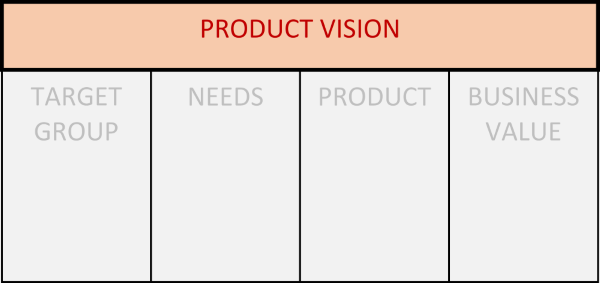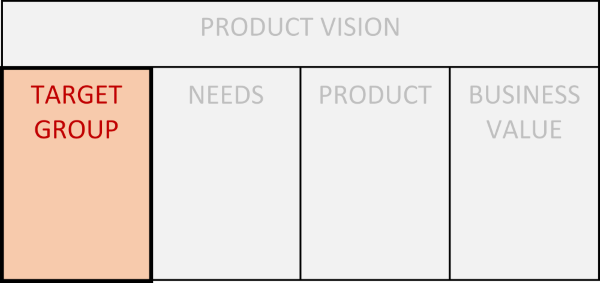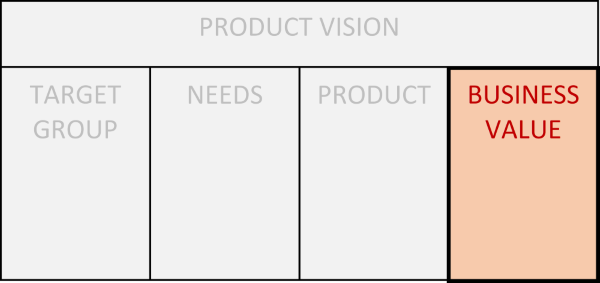
The Product Vision Board (developed by Roman Pichler) is a simple visual tool that captures the product vision and its associated attributes. These include target group, user needs, key product features, and business goals. The Product Vision Board gathers all relevant information in one place and is a useful reference point for product-related decisions. It is an important part of the Emerging Humanity toolbox because it helps entrepreneurs remain connected to their vision while developing their product.

Product Vision is a description of the overarching goal that you intend to accomplish with your product. Your vision statement concisely states what you seek to achieve by bringing it to the market.
It is also useful to identify a list of keywords that capture the key product ingredients. These can be used as quick reference for product related decisions and to align team members with the essential character of the product.
For instance, Airbnb's vision is to "create a world where people can belong anywhere and can live a place instead of just travelling to it". They strive to make the traveler feel like a local and they "sell" a sense of belonging (in alignment with their vision). Thanks to the economics of their supply (privately-owned as opposed to professional accommodation) they can also offer a wider range of options compared to hotels. Based on the above, Airbnb's product keywords could be: Belonging, Homey Feeling, Local Experience, Variety/Choice.

Target Group is the market segment that will benefit from your product. It includes your product's users or customers. It represents a hypothesis about your ideal customers or the people you want to serve with your product.
For startups, the Target Group includes the "Earlyvangelists" of the product. These are the early adopters of your product, the customers who are willing to take a risk on your new product or service. They identify with the product vision and are willing to work with you. When filling this box focus on the customers who can buy into the vision and love the idea, not on the solution you will provide to them. Describe these people and their various characteristics. Include full personas if you have them.

Needs are the gains or the benefits that the product creates for its users. They represent the value that the product adds to the customers and the problems it removes. The section includes the problem hypothesis and how the product plans to address it.
When filling this section, be clear why people will be interested in buying and using the product. Focus on the product's value proposition in the market. Understand the problems that customers face and avoid focusing too much on what you want them to be. Use this approach to come up with a good problem hypothesis before proceeding to the next section.

Product is a summary of three to five unique features of your product. It represents the solution hypothesis or what you can do to solve the problem that customers are experiencing. The features are what makes your product stand out and increase chances of success.
The features may correlate with the product's unique selling proposition and address customers' needs. They may relate to functional properties, design, technologies, and user experience. Think of features that you can build and use to see if they make your customer happy. When filling this box, stick to a maximum of five features to avoid the temptation of listing too much information. You can capture additional details later in your Product Backlog.

Business Value or Goals explain the importance of investing in the product. When filling this section, you need to state your desired business benefits. Some examples are reduction in cost, increase in revenue, brand development, entering a new market, or acquiring valuable knowledge. Whatever business value you choose, the other boxes should support it.
For first timers, especially startups, you can include market entry goals as you still need more time to gather information about your product. Since all the other boxes are hypotheses, they will need time to be tested and validated. Some of the hypotheses may change along the way providing a clearer definition of your business value.
The Vision Board is a thinking and communications tool that can be used to test assumptions and capture new insights. By capturing the target group, needs, product and business values all in one place, it helps to both visualize and validate your product's vision and strategy.
The Product Vision Board becomes more useful & powerful when engaging the right people. Include views from customers, team members, the product owner, and internal stakeholders in order to capture multiple perspectives. Make sure you envision the product from the context of the user and their needs.
One of the risks when creating a product is misunderstanding the needs of the user. This can result in building a product that adds no value to your customers. The Product Vision Board can help you identify risky assumptions and approach them in a systematic way. To test your assumptions, you may conduct structured conversations or interviews with individual users in order to understand their goals and problems. It may also be helpful to conduct direct observation sessions to get a clearer perspective of the customers and how they would use the product.
Validating your hypotheses will help you better understand your target audience and test the feasibility of your product in providing value to them. This iterative process is essential in creating a vision board that better represents your customers. When done right, it should clearly capture your product vision and give you a path of how to get there!
We Help Visionary Tech Entrepreneurs Build Impactful Companies!